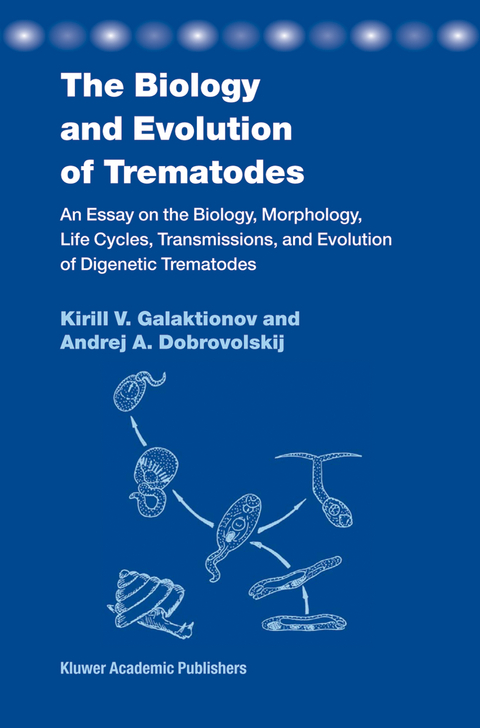
The Biology and Evolution of Trematodes
An Essay on the Biology, Morphology, Life Cycles, Transmissions, and Evolution of Digenetic Trematodes
Seiten
2003
Springer-Verlag New York Inc.
978-1-4020-1634-9 (ISBN)
Springer-Verlag New York Inc.
978-1-4020-1634-9 (ISBN)
In the beginning (Chapter 1), the authors provide a consistent analysis of the morphological features of all life cycle stages. This is followed by a detailed consideration of the various m- phological-biological adaptations that ensure the successful completion of the complex life cycles of these parasites (Chapter 2).
The book by K. V. Galaktionov and A. A. Dobrovolskij maintains the tra- tion of monographs devoted to detailed coverage of digenetic tr matodes in the tradition of B. Dawes (1946) and T. A. Ginetsinskaya (1968). In this - spect, the book is traditional in both its form and content. In the beginning (Chapter 1), the authors provide a consistent analysis of the morphological features of all life cycle stages. Importantly, they present a detailed char- terization of sporocysts and rediae whose morphological-functional orga- zation has never been comprehensively described in modern literature. The authors not only list morphological characteristics, but also analyze the functional significance of different morphological structures and hypothesize about their evolution. Special attention is given to specific features of m- phogenesis in all stages of the trematode life cycle. On this basis, the authors provide several original suggestions about the possible origins of morp- logical evolution of the parthenogenetic (asexual) and the hermaphroditic generations. This is followed by a detailed consideration of the various m- phological-biological adaptations that ensure the successful completion of the complex life cycles of these parasites (Chapter 2). Life cycles inherent in different trematodes are subject to a special analysis (Chapter 3). The authors distinguish several basic types of life cycles and suggest an original interpretation of their evolutionary origin. Chapter 4 features the analysis of structure and the dynamics of trematode populations and is unusual for a monograph of this type.
The book by K. V. Galaktionov and A. A. Dobrovolskij maintains the tra- tion of monographs devoted to detailed coverage of digenetic tr matodes in the tradition of B. Dawes (1946) and T. A. Ginetsinskaya (1968). In this - spect, the book is traditional in both its form and content. In the beginning (Chapter 1), the authors provide a consistent analysis of the morphological features of all life cycle stages. Importantly, they present a detailed char- terization of sporocysts and rediae whose morphological-functional orga- zation has never been comprehensively described in modern literature. The authors not only list morphological characteristics, but also analyze the functional significance of different morphological structures and hypothesize about their evolution. Special attention is given to specific features of m- phogenesis in all stages of the trematode life cycle. On this basis, the authors provide several original suggestions about the possible origins of morp- logical evolution of the parthenogenetic (asexual) and the hermaphroditic generations. This is followed by a detailed consideration of the various m- phological-biological adaptations that ensure the successful completion of the complex life cycles of these parasites (Chapter 2). Life cycles inherent in different trematodes are subject to a special analysis (Chapter 3). The authors distinguish several basic types of life cycles and suggest an original interpretation of their evolutionary origin. Chapter 4 features the analysis of structure and the dynamics of trematode populations and is unusual for a monograph of this type.
From the contents:
Preface. Introduction. Acknowledgements.- 1: Organization of parthenogenetic and hermaphroditic generations of trematodes.- 2: The trematode life cycle as a system of adaptations.- 3: The main types of trematode life cycles.- 4: Specific traits of populations formed by trematodes.- 5: The main trends in trematode evolution.- 6: Evolution of life cycles and phylogeny of trematodes.- References.- Index.
| Erscheint lt. Verlag | 31.10.2003 |
|---|---|
| Zusatzinfo | 12 Illustrations, black and white; XX, 592 p. 12 illus. |
| Verlagsort | New York, NY |
| Sprache | englisch |
| Maße | 160 x 240 mm |
| Themenwelt | Naturwissenschaften ► Biologie ► Mikrobiologie / Immunologie |
| Naturwissenschaften ► Biologie ► Zoologie | |
| ISBN-10 | 1-4020-1634-4 / 1402016344 |
| ISBN-13 | 978-1-4020-1634-9 / 9781402016349 |
| Zustand | Neuware |
| Haben Sie eine Frage zum Produkt? |
Mehr entdecken
aus dem Bereich
aus dem Bereich
Allgemeine Grundlagen und spezielle Anwendungen
Buch | Softcover (2021)
Springer Berlin (Verlag)
54,99 €


